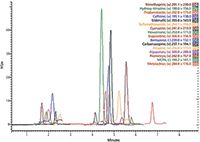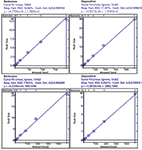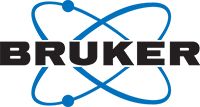Keeping Water Safe: Detecting Pharmaceutical and Personal Care Products in Water Using Liquid Chromatography–Mass Spectrometry
Pharmaceutical and personal care products (PPCPs) are products used for personal health or cosmetic reasons.
The Problem with PPCPs
Pharmaceutical and personal care products (PPCPs) are products used for personal health or cosmetic reasons. This category includes a broad group of chemical substances such as human and veterinary medicines and cosmetics. The presence of PPCPs in environmental and potable water is a widespread concern due to the potentially harmful environmental effects. Evidence suggests PPCPs are linked to some ecological damage such as the delayed development in fish (1).
To ensure the safety of water, PPCP concentrations are stringently monitored by environmental regulatory bodies, including the United States Environmental Protection Agency (US EPA) (2). Detection of PPCPs is traditionally a complicated process due to the range of substances potentially present. Here we explore a simple, more convenient method than traditional solid phase extraction (SPE) based methods for highly sensitive PPCP detection, using triple quadrupole liquid chromatography–mass spectrometry (LC–MS-MS).
Detecting PPCPs
Conventional methods of PPCP detection in clean water have followed the defined EPA 1694 "template" for analysis which requires the pre-concentration of large volume water samples and tedious solid phase extraction cleanup, followed by liquid chromatography–mass spectrometry analysis in order to achieve the low ng/L (ppt) level detection necessary to comply with regulations (3).

Figure 1: PPCPs in environmental water and nearby soil is a widespread concern.
Bruker has explored how LC–MS-MS can be employed specifically for the analysis of PPCPs in clean water. PPCPs were detected at 1–2 ppt with a linear response up to 200 or 500 ppt. Excellent system robustness was obtained throughout the extended method development and sample analysis period.

Figure 2: Selected MRM chromatograms for PPCPs at 2 ppt.
Case Study: Using LC–MS-MS to Analyze PPCPs in Clean Water
The study was carried out using ultrahigh-performance liquid chromatography (UHPLC) with an integrated on-line extraction (OLE) option coupled to a triple quadrupole mass spectrometer. The OLE module enables convenient method-driven on-line sample cleanup or sample pre-concentration.

Figure 3: Selected calibration curves.
Several water samples were analyzed for a range of PPCP species, including tap water samples along with bottles and creek water. Samples were analyzed targeting a wide range of PPCP species representing compounds displaying varied properties and concentrations. Tables Ia and Ib illustrate the Advance UHPLC and EVOQ instrumentation set up respectively.

Tables Ia & Ib: Instrumentation set up for analysis of PPCPs in clean water
All of the PPCPs were detected at 2 ppt or better with the injection of 0.4 mL samples with a linear response range up to 200 or 500 ppt. The fast polarity switch can analyze positive and negative PPCPs in the same analytical segment with excellent linear response for both polarities (Figures 2 and 3). The results for the analysis of tap, creek, and bottled waters are shown in Table II.

Table II: Test results for selected PPCPs in real water samples
Conclusion
The Bruker Advance UHPLC with OLE coupled to EVOQ LC–MS-MS detected PPCP samples at 2 ppt or better within 0.4 mL samples. Excellent linearity, sensitivity, and robustness were achieved throughout. The technique presents a more convenient and simpler approach to PPCP analysis than traditional SPE-based methods.
References
(1) K. Hirsch, "Pharmaceuticals and Personal Care Products," (2013). Available at: http://serc.carleton.edu/NAGTWorkshops/health/case_studies/pharmaceutical.html.
(2) US EPA, "PPCPs Basic Information," (2010). Available at: http://www.epa.gov/ppcp/basic2.html.
(3) US EPA, "EPA Method 1694: Pharmaceuticals and Personal Care Products in Water, Soil, Sediment, and Biosolids by HPLC/MS/MS," (2007).

Bruker Daltonics Inc.
40 Manning Road, Billerica, MA 01821
tel. (978) 663-366-, fax (978) 667-5993
Website: www.bruker.com

Separation of Ultra-Short and Long Chain PFAS Compounds Using a Positive Charge Surface Column
December 11th 2024A separation of ultra-short and long chain PFAS (C1-C18) is performed on a HALO®PCS Phenyl-Hexyl column along with a HALO®PFAS Delay column which demonstrates excellent retention for both hydrophilic and hydrophobic analytes.















